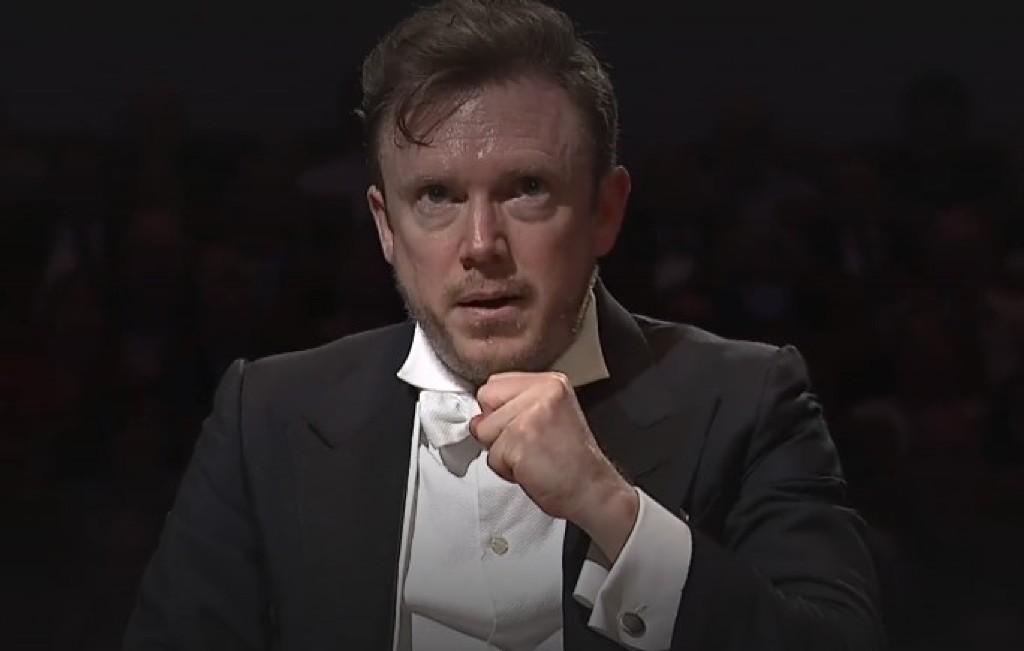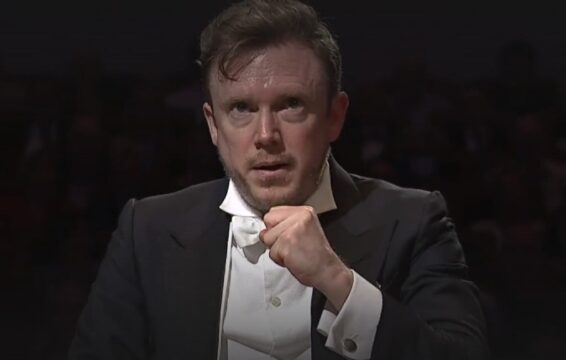Strange place in the work of Gustav Mahler that this Seventh Symphony in E minor, which has always been shunned at the concert, a little cramped between the implacable Sixth and the luminous and massive Eighth. However, and the brilliant execution of this exceptional evening will reinforce this judgment, this score, created in Prague in 1908 under the baton of the composer himself, is perhaps his masterpiece, undeniably the most accomplished, the densest and most modern of all, therefore, the most disconcerting. There is no denying the obvious technical excellence and perfect virtuosity of the Bavarian Radio Symphony Orchestra, conducted this evening by Daniel Harding, who is astoundingly committed and intelligent. Poem of the night in five acts, celebrated by Schönberg, fascinated by its strange harmonies and its floating tonality, the Seventh Symphony is known for its enigmatic character, oscillating between pathos, irony and macabre creaks, so many cliches often plastered over Mahler’s works. After such a wonderful concert, it seems to be necessary to revise this hasty judgment thanks to the joyful and teeming with ideas vision proposed by Daniel Harding. A first movement sequel to the tragic Sixth The English conductor imposes from the first chords a nervous, tense, uncompromising direction. The last breaths of the terrifying finale of the Sixth Symphony can be heard. In his initiatory journey, the hero is not buried, he is out of breath, almost overthrown, but still alive. The march then resumes its course, in a futuristic dynamic that anticipates the sculpture Unique Forms of Continuity in space (Forme uniche della continuità nello spazio in Italian) by Umberto Boccioni (1913). Already pass some distant echoes of a derisory Viennese waltz. Peremptory accents, revealing a continuity between all the symphonies, remind us of the echoes of the cavalry of Mahler’s childhood, these military marches which are lost in the distance and give the resolutely autobiographical tone of the work, as in the Titan1. Suddenly, pianissimi establish an early Ravelian nocturnal climate, ghostly rustling in the grass, a great moment of poetry, led by seraphic harps. Harding sets the tone : all the subtleties of the score are revealed, the orchestra seems to be capable of responding to all requests, it is technical perfection, coupled with a real vision and an increasingly pictorial will : actually, the end of the movement gains altitude and shows us dolomitic landscapes passing by, in a quintessential atmosphere that Strauss will remember in his Alpine Symphony, this limpid summer air smelling of the hay of the plain, above contingencies of existence. A Goyesque Nachtmusik The second movement is often perceived as a kind of pictorial translation of Rembrandt’s Night Watch, exhibited a stone’s throw from the Concertgebouw hall, but Harding moves away from expectations by offering a more pastoral reading, in the continuity of the poetic moments of the previous movement : something is brewing, rustling in the grass, an unspeakable sarcasm, a waltz of small skeletons, in a more Goyesque evocation which, with a subtle art of naturalistic miniature, nostalgic reminiscences of memories of the forests of the Mahler’s native Bohemia. Moreover, the cowbells are discreet (behind the scenes, you can hardly hear them) and it is rather the vaguely mocking atmosphere of Goya’s caricatures that come to mind, these derisory vestiges of a deleterious aristocracy which will soon waltz on the disaster. It’s exciting, rich, contrasting. A cubist Scherzo The third movement deploys poisonous and cubist charms, abstract jolts, insidious stridency, in an atmosphere of a macabre waltz, described as the musical transposition of the skeletons painted on the panels of the Luzern bridge. But once again, Harding goes against expectations and the oboes awaken old melodies and lullabies, Mahler burying his childhood here with the romanticism of which Apollinaire could be the perfect poetic equivalent, « Sun cut throated »2, twilight. Through collages of different musical eras, carefully revealed by Harding, Mahler’s entire mental landscape scrolls by, we feel that he is struggling with the past, through resurrections that are as personal as they are musical. Doctor Freud is knocking on the door… Here is a disconcerting and psychoanalytical movement from afar. The second Nachtmusik, Harlequin and Colombine, Gustav and Alma The violin then begins a Neapolitan miniature, where Harlequin is courting a mischievous and distant Colombina. Harding executes this movement without complacency or sentimentality, hinting at a moment of delicious irony, more in line with what the listener may know. Guitar, mandolin and oboe (the voice of the heart !) converse in perfect harmony, the timbres merge and overlap seamlessly, in unison, while the basses scroll through darker colors in this gallant act. Everything ends in celestial pianissimi. A disheveled, Dionysian and jubilant finale How to describe this explosive contrast, this cavalcade described many times as a kind of parody of Wagner’s Meistersinger von Nürnberg ? The conductor once again takes the opposite view of this distanced and ironic reading to make us hear – finally! – a more blunt vision, a jubilant release, giving all its meaning to the aesthetics of the collage that will later inspire Ives : everything here is smiling and communicative joy, even if melancholy still hides in the male accents of the double basses or the sneers of the bassoons. The conductor leads us to the light, with a virtuoso orchestra drunk with a Dionysian celerity, superlative brass instruments, announcing the triumph of the beginning of the Eighth Symphony. We can notice the quotations from Mozart (The Abduction from the Seraglio and The Twelve Variations for piano which quote Weckerlin’s aria “Ah! Vous dirai-je, maman”, Twinkle Twinkle Little Star). A phrase by Rimbaud, which was a hit, comes to mind: “abracadabrantesque” movement, fairground hustle and bustle, funeral with flowers and wreaths of Austrian music (even The Merry Widow crosses the score!), it is a delirium of sounds, a jubilant race to which Harding and his musicians invite us, a harmonious cacophony, unleashed percussion, each section giving it their all, right up to the final bells which seem to mark Mahler’s victory over his shadows, far , very far away from the morbid image sometimes attached to this composer. When the last chords ring out, I hear laughter in the audience and wide smiles light up everyone’s face, it’s a triumph and a long deserved standing ovation for this evening. To put it in a nutshell, attending such a concert, in one of the most beautiful halls in the world – the Concertgebouw, ideal for happily restoring the shimmering polyphony of this work – with one of the greatest orchestras in the world, and a unique Mahlerian leader was a great privilege. Philippe ROSSET 26 Mai 2023 1 Mahler’s First Symphony 2 Last words of « Zone », first poem in Apollinaire’s Alcools (« Soleil cou coupé » in French)



